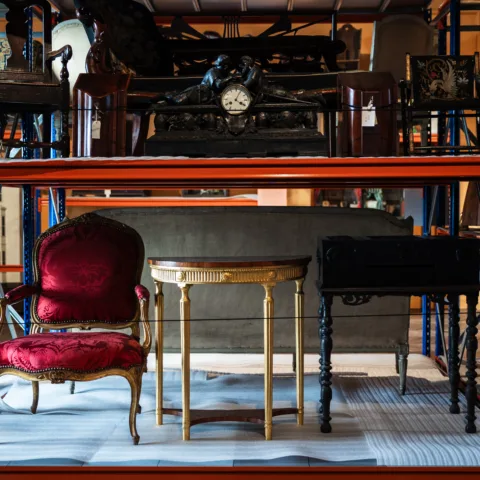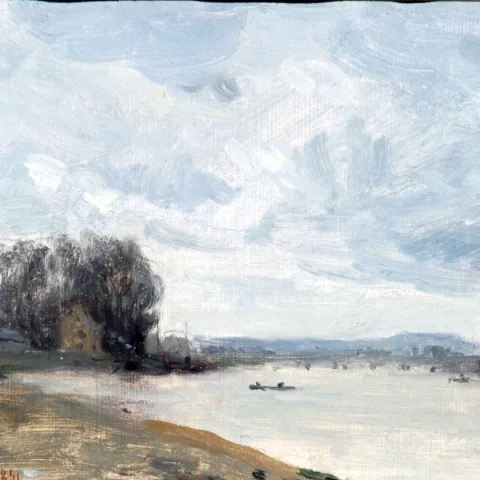The Bowes Museum Blog

This year’s star: The pig
The New Chinese Year starts today represented by the year of the Pig. The pig is one of the 12 animals that won ‘The Great Race’ set by the Jade Emperor, in Ancient China. It came last because it stopped for food and a nap but as a reward for finishing the race had the 12th year of the zodiac named after him. Or so the legend says. It is said that the characteristics of the pig are conscientiousness, generosity, calm and compassion but it can also be gullible and quiet.

Pigs by T. Horsley, oil on canvas, 1807
But how is the pig seen in other cultures? And what symbolism does it have in art?
In biblical or Islamic texts the pig is perceived as an unclean creature. In Christianity it is associated with violence, cruelty, lust and gluttony. In Buddhist illustrations the pig or wild boar is at the centre of the Samsara Wheel or Wheel of Life symbolizing sins of the flesh, passion and ignorance.
Unlike the exotic tiger or the loved dog, the cheeky monkey or the magnificent horse, the pig did not get as much ‘canvas’ time as other animals in the history of arts. Seen as living in its own filth, being lazy and unattractive you will not see many paintings with the pig as the main character.

A Peasant Girl feeding Pigs by Alexandre-Georges Fischer, oil on canvas, 1857
When it is depicted, it is usually associated with farm and everyday peasant life. You will never see a painting of a big sleepy pig adorning the feet of a gentleman or be stroked by the gentle hands of a high society lady. It was always linked with the lower classes, in farm barns or grazing on the green pastures of a landscape.
The wild boar is however represented in the history of art as one of the most desired hunting trophies. From allegorical or mythical themes, like the image below, to 17th century hunting scenes, the pig can be the focal point of an artwork, just not in the same way a horse might be.

A Boar Hunt, after Giulio Romano, oil on panel, early 16th century
This grisaille, or monochrome painting from The Bowes Museum Collection, a copy after a drawing by Giulio Romano, has as focal point the wild boar. In true baroque style, the painting dramatically represents an episode from Ovid’s Metamorphoses (VIII). If you think the wild boar is just there as trophy you are wrong. The goddess of hunting and wild animals, Artemis (Diana in Roman mythology) is using one of the animals associated with her, the wild pig, to ruin the land of Calydon. The animal is thus partaking in the main action, is not just chased for its head. King Meleager gathered a group of warriors to hunt the boar amongst which was the huntress Atalanta who he was in love with. After many adventures in the hunt for the boar’s head, Atalanta pins it down and Meleager cuts off its head. He presents the head as a gift to Atalanta, as an appreciation of her courage and his devotion. This did not go down very well with Meleager’s huntsmen. This simple boar hunt caused a war between the Calydonians and the Curetes, as well as Meleager’s death.
That is a pretty epic story for our humble wild pig. Not only at the centre of the painting but also a huge participant in the intrigue, proves that the wild boar had a great importance in the Greek mythology. Many paintings, prints and tapestries have been inspired by this myth and most of them feature the wild boar as a focus point.
This 18th century Derby ceramic is of the goddess Britannia (the equivalent of Artemis or Diana) name attributed to the British Island by the Romans. We can see she has a helmet, breast plate and a beautifully decorated shield, indicating she is ready for hunting… some wild boar, maybe?

There are other cultures that, like the Chinese culture, appreciate the humble pig and identified it with earthly desires, abundance, honesty and trustworthiness.
The pig represents fertility in many cultures, with the sow being seen in the Egyptian, Celtic and Hindi cultures as a Great Mother or a maternity figure. The Ancient Greeks and Native Americans saw the pig as a symbol of agriculture, abundance, great sacrifice for the Gods and again fertility.
The wild boar represents in some cultures masculinity and earthly connections.
We can’t predict what the pig is going to bring this year but are definitely going to keep positive and trust all the ancient beliefs that made the humble animal a leader in the first place.
Gong Xi Fa Cai or Happy New Chinese Year!







